Gross Motor Skills in Early Childhood
Slide 1 of 10: Synopsis

Author
S. Stavros Valenti, Hofstra University
Synopsis
This activity explores the development of gross motor skills throughout early childhood. After learning how and when gross motor skills develop, you will have an opportunity to identify a variety of gross motor skills demonstrated by young boys and girls in a video clip.
Slide 2 of 10: Gross Motor Skills: Moving Around in the World

Between two and six years of age, children all over the world show tremendous gains in their abilities to move around and participate in the world. To get to where they want to go, they do not just walk. Now, they hop, skip, jump, run, and rarely will they give up an opportunity to climb! These physical skills involving large muscle groups and coordinated control of arms, legs, head, and torso are called gross motor skills. In contrast, other physical skills that involve much smaller and precise movements, such as writing with a pencil or tying a shoe, are called fine motor skills, and they take more time to develop.
Slide 3 of 10: How Do These Skills Develop Over Time?
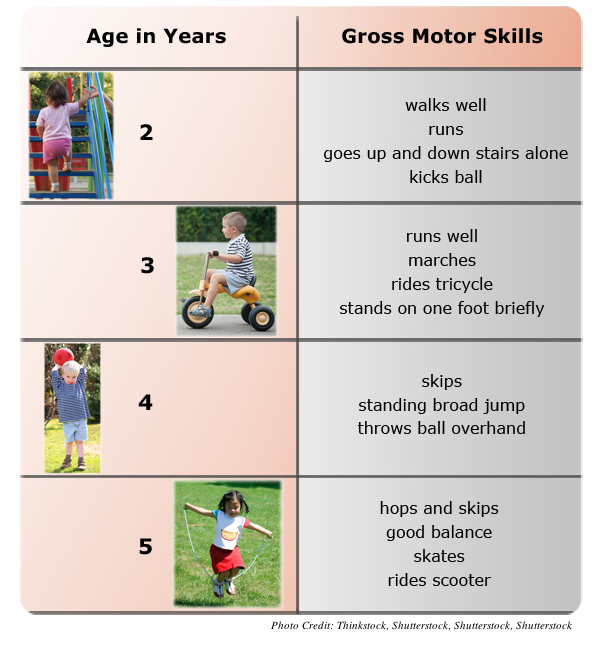
Children develop gross motor skills primarily through watching other children and through self‐initiated practice during play and exploration. Learning gross motor skills does not actually require direct instruction. Instead, it is fair to say that children have an innate need to move their bodies. It just feels good to run, skip, and jump! Developmentalists refer to this desire to move as motor drive.
As their strength gradually increases relative to their body weight, children become slimmer and less top‐heavy. With this physique, their gross motor skills improve with repeated practice. Children take great pride in their ability to move their bodies with skill, and the development of these skills contributes to their overall self‐esteem.
The table below lists examples of gross motor skills and the typical age at which they first appear.
Slide 4 of 10: Do Boys and Girls Differ in Gross Motor Skills?
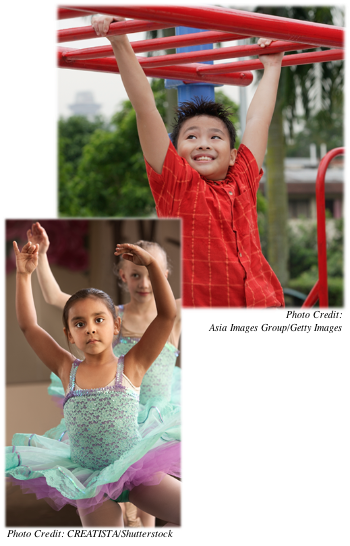
Boys can, on average, jump a little higher, run a little faster, and throw a ball about five feet farther than girls can. Boys generally perform better in skills that require strength, especially upper body strength.
Girls also have areas of excellence. On average, girls demonstrate better balance and agility than boys do, and girls excel in complex foot movements. This deftness gives girls an edge in gymnastics and dance.
While groups of boys and girls may differ on average, this does not mean that girls always show less strength or that boys always show less agility. The degree of encouragement from parents and peers in addition to the availability of opportunities to practice various skills determine which abilities any particular boy or girl will develop.
Slide 5 of 10: Identify the Gross Motor Skills
- Chapters
- descriptions off, selected
- captions settings, opens captions settings dialog
- captions off, selected
- English Captions
This is a modal window.
Beginning of dialog window. Escape will cancel and close the window.
End of dialog window.
This is a modal window. This modal can be closed by pressing the Escape key or activating the close button.
This is a modal window.
Here, you will have an opportunity to observe and identify some of the gross motor skills that we have discussed. This video clip shows children engaged in a variety of activities. Watch the video clip from start to finish one or two times to get a sense of the range of activities. As you watch, ask yourself “Which of these actions are gross motor skills?” Remember that gross motor skills involve the large muscle groups of the body, such as running, throwing, jumping, hopping, and climbing.
Slide 6 of 10: Summary

To review some of the main points discussed in this activity…
Gross motor skills refer to large movements of the body, such as waving the arms, walking, running, or climbing.
Gross motor skills require self‐initiated practice and are usually not taught directly.
Boys typically excel in gross motor skills that require strength, such as running fast or throwing far, whereas girls generally demonstrate proficiency in skills that require coordination and agility, such as gymnastics.
Children everywhere take great pleasure and pride in their movement skills. Running, jumping, throwing, climbing, and hanging are just some of the giant steps in the journey through childhood.
Slide 7 of 10: Assessment: Check Your Understanding
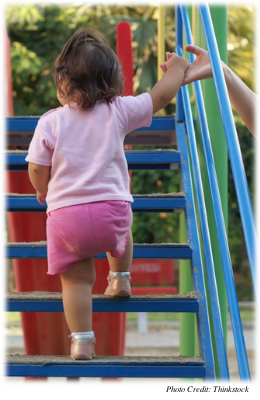
Slide 8 of 10: Assessment: Check Your Understanding
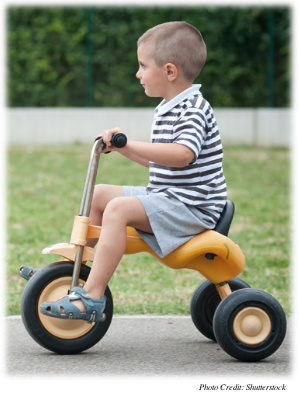
Slide 9 of 10: Assessment: Check Your Understanding
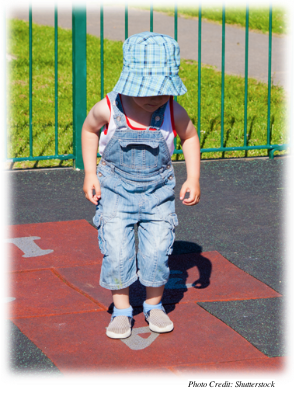
Slide 10 of 10: Assessment: Check Your Understanding
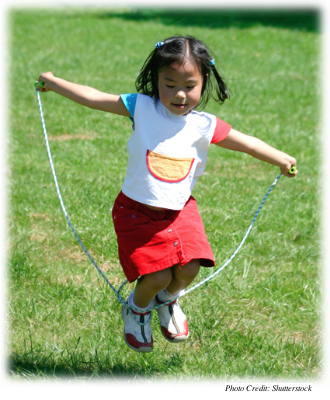
Congratulations! You have completed this activity.Total Score: x out of x points (x%) You have received a provisional score for your essay answers, which have been submitted to your instructor.